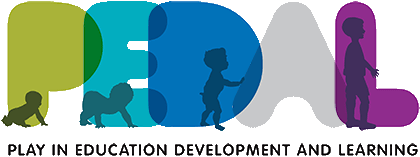Embracing complexity: Rethinking the relation between play and learning: Comment on Lillard et al. (2013)
Lillard et al. (2013) concluded that pretend play is not causally related to child outcomes and charged that the field is subject to a play ethos, whereby research is tainted by a bias to find positive effects of play on child development. In this commentary, we embrace their call for a more solidly scientific approach […]
Lillard et al. (2013) concluded that pretend play is not causally related to child outcomes and charged that the field is subject to a play ethos, whereby research is tainted by a bias to find positive effects of play on child development. In this commentary, we embrace their call for a more solidly scientific approach to questions in this important area of study while offering 2 critiques of their analysis. First, we urge researchers to take a more holistic approach to the body of evidence on play and learning, rather than relying on piecemeal criticisms of individual studies, since positive effects of play on learning emerge despite the use of a variety of methods, contents, and experimental conditions. Second, we consider how best to study this topic in the future and propose moving away from traditional empirical approaches to more complicated statistical models and methods that will allow us to embrace the full variety and complexity of playful learning. (PsycINFO Database Record (c) 2016 APA, all rights reserved)
Why Play? Examining the Roles of Play in ICTD
Please click on the link provided below to read the abstract.
Please click on the link provided below to read the abstract.
The Importance of Play in Promoting Healthy Child Development and Maintaining Strong Parent-Child Bonds
Please click on the link provided below to read the abstract.
Please click on the link provided below to read the abstract.
Preclinical Modeling of Primal Emotional Affects (SEEKING, PANIC and PLAY): Gateways to the Development of New Treatments for Depression
Mammalian brains contain at least 7 primal emotional sys- tems – SEEKING, RAGE, FEAR, LUST, CARE, PANIC and PLAY (capitalization reflects a proposed primary-process terminol- ogy, to minimize semantic confusions and mereological falla- cies). These systems help organisms feel affectively balanced (e.g. euthymic) and unbalanced (e.g. depressive, irritable, manic), providing novel insights for understanding human […]
Mammalian brains contain at least 7 primal emotional sys- tems – SEEKING, RAGE, FEAR, LUST, CARE, PANIC and PLAY (capitalization reflects a proposed primary-process terminol- ogy, to minimize semantic confusions and mereological falla- cies). These systems help organisms feel affectively balanced (e.g. euthymic) and unbalanced (e.g. depressive, irritable, manic), providing novel insights for understanding human psychopathologies. Three systems are especially important for understanding depression: The separation distress (PAN- IC) system mediates the psychic pain of separation distress (i.e. excessive sadness and grief), which can be counteracted by minimizing PANIC arousals (as with low-dose opioids). De- pressive dysphoria also arises from reduced brain reward- seeking and related play urges (namely diminished enthusi- asm (SEEKING) and joyful exuberance (PLAY) which promote sustained amotivational states). We describe how an under- standing of these fundamental emotional circuits can pro- mote the development of novel antidepressive therapeutics – (i) low-dose buprenorphine to counteract depression and suicidal ideation emanating from too much psychic pain (PANIC overarousal), (ii) direct stimulation of the SEEKING sys- tem to counteract amotivational dysphoria, and (iii) the dis- covery and initial clinical testing of social-joy-promoting mol- ecules derived from the analysis of the PLAY system.
Play and Problem Solving; An Elusive Connection
The hypothesis tested was that play provides the opportunity to observe features of the environment which are likely to be overlooked in more goal directed encounters with the environment. Children (n = 45), ages 5 to 8 years, were randomly assigned to a play group, a narrow-focus goal-directed group, or a broad-focus goal-directed group. Children […]
The hypothesis tested was that play provides the opportunity to observe features of the environment which are likely to be overlooked in more goal directed encounters with the environment. Children (n = 45), ages 5 to 8 years, were randomly assigned to a play group, a narrow-focus goal-directed group, or a broad-focus goal-directed group. Children in the broad-focus group recalled and recognized significantly more features of the environment than did the other two groups. The narrow-focus group traversed more of the environment than the other groups, yet recognized and recalled the least number of objects, suggesting that exposure per se is not a critical element. Further comparisons indicated that one advantage of the broad-focus group was the opportunity to touch more objects, although the psychological nature of the touch (e.g., goal-directed vs. play) had little impact on subsequent task performance.
Assessing and Scaffolding: Make-Believe Play
It is the third week that Ms. Sotto’s preschool classroom has been turned into an airport. The literacy center is a ticket counter, with a travel agency complete with child-made passports, tickets, and travel brochures. What is happening in Ms. Sotto’s classroom is an example of what most early childhood educators mean when they talk […]
It is the third week that Ms. Sotto’s preschool classroom has been turned into an airport. The literacy center is a ticket counter, with a travel agency complete with child-made passports, tickets, and travel brochures. What is happening in Ms. Sotto’s classroom is an example of what most early childhood educators mean when they talk about make-believe play–a fantasy world created by children where their imagination soars, their language expands, and their social skills develop. Mature make-believe play is an important and unique context, providing opportunities to learn not afforded by other classroom activities. It should not be considered something extra that can be cut to accommodate more time for academic skills, nor should it be used as a means of adding “entertainment value” for inherently boring and decontextualized drills. Instead, play should be preserved and nurtured as one of the “uniquely preschool” activities that provide the most beneficial context for children’s development.
Best Practices in Play Assessment and Intervention
Literacy objects as cultural tools: Effects on children’s literacy behaviors in play
This study examined the effects of literacy-enriched play settings on preschoolers’ literacy behaviors in spontaneous free play. 91 children, ages 3-5, from two urban day-care centers participated in the study. Prior to and following the intervention, the frequency of each child’s handling, reading, and writing behaviors in play was assessed through direct observation. Videotaped samples […]
This study examined the effects of literacy-enriched play settings on preschoolers’ literacy behaviors in spontaneous free play. 91 children, ages 3-5, from two urban day-care centers participated in the study. Prior to and following the intervention, the frequency of each child’s handling, reading, and writing behaviors in play was assessed through direct observation. Videotaped samples of play areas examined the nature of children’s play themes and their uses of literacy objects in play. Following baseline observations, the physical environment of one of the day-care centers was enriched with literacy objects in three distinct play centers: kitchen, office, and library. Significant differences were recorded for the intervention group in the frequency, duration, and complexity of literacy demonstrations in play. Further, children in the intervention group incorporated literacy objects in more diverse and functional ways in their play, using more explicit language than the nonintervention group.
Habituation and Maternal Encouragement of Attention in Infancy as Predictors of Toddler Language, Play, and Representational Competence.
Infants’ habituation and mothers’ encouragement of attention were assessed at 5 months. Toddlers’ language comprehension, language production, and pretense play, and mothers’ encouragement of attention, were assessed at 13 months. Examined the contributions of infant habituation and maternal stimulation to toddlers’ cognitive abilities. (PCB)
Infants’ habituation and mothers’ encouragement of attention were assessed at 5 months. Toddlers’ language comprehension, language production, and pretense play, and mothers’ encouragement of attention, were assessed at 13 months. Examined the contributions of infant habituation and maternal stimulation to toddlers’ cognitive abilities. (PCB)
Adult modelling facilitates young children’s generation of novel pretend acts
The present work investigated the effect of modelling on children’s pretend play behaviour. Thirty-seven children aged between 27 and 41 months were given 4 min of free play with a dollhouse and associated toy props (pre-modelling phase). Using dolls, an experimenter then acted out a series of vignettes involving object substitutions, imaginary play and attribution […]
The present work investigated the effect of modelling on children’s pretend play behaviour. Thirty-seven children aged between 27 and 41 months were given 4 min of free play with a dollhouse and associated toy props (pre-modelling phase). Using dolls, an experimenter then acted out a series of vignettes involving object substitutions, imaginary play and attribution of properties. Children were subsequently provided with an additional 4 min free play (post-modelling phase). Consistent with past research, more pretence was exhibited after modelling than before. Furthermore, in the post-modelling phase, children were as likely to generate their own novel pretence as they were to copy the actions demonstrated by the experimenter. They also increased the number of novel symbolic acts involving imaginary play from the pre- to the post-modelling phase. This study highlights how young children will not only imitate a model’s demonstration of pretend acts but also use this demonstration to catalyze the creation of their own pretence. Copyright © 2008 John Wiley & Sons, Ltd.


